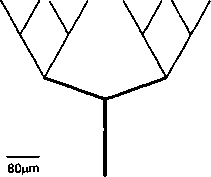87

Figure 3.6: Rendering of a binary branching cell of depth 3 obeying Rall’s 3/2 power
law. The root branch has length 200 μm and radius 8 μm, agreeing with the morphological
parameters as given in Rallpack 2 of (Bhalla et al., 1992).
Table 3.5: Performance of reduced model (here kυ = kj') of HH Rail cells of depth 3 for
tapered and non-tapered branches as compared with the full model (A = 1823).
|
Speed-up |
% Matched |
% Mismatched |
Γ | |
|
30, tapered |
19.0× |
95.9 |
1.1 |
0.974 |
|
30, non-tapered |
18.9× |
79.2 |
8.9 |
0.836 |
|
40, non-tapered |
14.8× |
91.5 |
5.6 |
0.847 |
|
50, non-tapered |
12.0× |
93.9 |
5.4 |
0.874 |
dynamics to high accuracy. The tapered cell is less excitable than the non-tapered
cell (which may be expected since there are more compartments with greater surface
areas in the tapered cell). Also, the non-tapered cell requires a larger reduced system
to capture the dynamics, which suggests that cells with smoothly varying dendritic
radii may yield better results than cells whose radii change abruptly.
3.4 Results on Realistic Morphologies
3.4.1 Results on Neuron AR-l-20-04-A
Consider the projection interneuron AR-l-20-04-A (Martinez), which has 35 bran-
ches and 20 leaves. At 1 μm resolution, the full system has N = 2233 compartments.
More intriguing information
1. The name is absent2. Globalization, Redistribution, and the Composition of Public Education Expenditures
3. Epistemology and conceptual resources for the development of learning technologies
4. Three Strikes and You.re Out: Reply to Cooper and Willis
5. Top-Down Mass Analysis of Protein Tyrosine Nitration: Comparison of Electron Capture Dissociation with “Slow-Heating” Tandem Mass Spectrometry Methods
6. Putting Globalization and Concentration in the Agri-food Sector into Context
7. The name is absent
8. Testing Hypotheses in an I(2) Model with Applications to the Persistent Long Swings in the Dmk/$ Rate
9. Estimating the Economic Value of Specific Characteristics Associated with Angus Bulls Sold at Auction
10. The name is absent